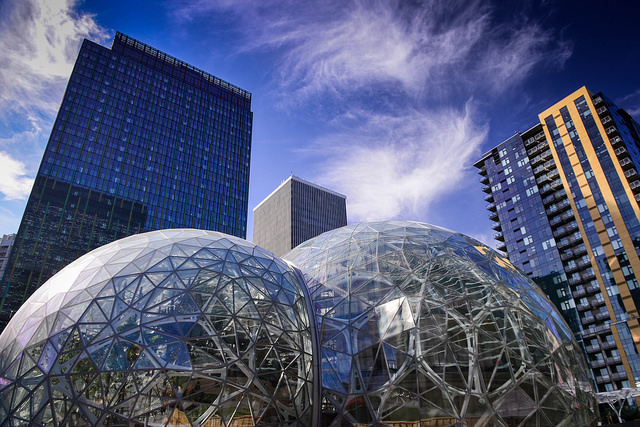Amazon recently released its request for proposals for a massive second headquarters. They're looking for a space starting at 500,000 square feet that could expand to eight million square feet, about twice the size of the Merchandise Mart or the Willis Tower's rentable square feet. It would employ 50,000 people—compared to about 350,000 employed by the top 25 employers in the Chicago area combined.
Such a massive investment is almost certainly going to set off a tax-incentive street fight between the nation's biggest cities, especially after the state of Wisconsin offered up to $3 billion in tax incentives for the creation of 13,000 jobs to the massive Chinese manufacturer Foxconn.
Much will happen behind the scenes to offer Amazon a tax deal. Until then, the rest of us can argue sites and statistics that meet the company's list of demands, which will narrow the company's search considerably: metros with more than a million people, a "strong university system" with graduates in fields relevant to its business, good and diverse mass transit, a location 45 minutes from an international airport, a good housing market, and a diverse population.
Chicago scores highly on a lot of these criteria. Take the Old Main Post Office, one building that's been kicked around as a location: It's 2.5 million square feet, less than a quarter-mile from the Blue Line, and right across the street river from the LaSalle Street Metra Station, in an area that's quickly adding residential density.
Crain's John Pletz ran some of the numbers on our workforce, and shows that Chicago has a good case: We are one of only four metros that pump out 10,000 tech grads every year, with the fifth-biggest tech-labor market in the country (behind the Bay Area, D.C., New York, and Dallas-Fort Worth, and just ahead of Seattle). But you could even push it further than that: According to the Illinois Science & Technology Coalition, 2,500 people graduated from its universities with computer-science degrees in 2015, the second-most in the country, despite being the fifth-largest state, with a high percentage of those graduates earning master's degrees.
The University of Illinois, one of the best computer-science schools in the country for over half a century, is a big driver of those numbers, but the city and state have a hard time retaining those graduates. "Chicago really does not have a calling-card industry," the urbanist Aaron Renn told the Tribune's Mark Caro in a piece about the subject. "Chicago does not have a lot of industries like that, where you have to be there."
But maybe it does, in the context of Amazon's search.
Amazon is basically two things: a tech company (website, Kindle, Fire, Echo, etc.) and a logistics company (selling everything to everywhere and delivering it quickly and inexpensively). Chicago has a decent-sized tech scene that could grow with demand by drawing from the state's universities, and those of its neighbors. But it has a very robust logistics industry.
In May, Chicago published a deep exploration of this huge but lesser-known field by Michael Lenehan (my old boss at the Chicago Reader). In essence, it's a synthesis of Amazon's core businesses:
Let’s say Best Buy asks for 10,000 Surface tablets; a kid in Portland buys an Xbox online; an OfficeMax in Skokie orders a dozen Bluetooth keyboards. All orders—up to 700,000 of them on a busy day—are funneled into Microsoft’s ERP system and from there into TMC’s software [Transportation Management Central, a creation of the Chicago logistics giant C.H. Robinson] , which consolidates the orders, arranges them into shipments, and figures out the best way to complete each one, whether it’s five ocean containers going from Shanghai to Long Beach or a single package headed from a Microsoft distribution center in California to an apartment in Lake View. At any time, Microsoft’s execs in Redmond, Washington (or anywhere), can look on a computer screen and get a street-level snapshot of any shipment in the system, along with the local weather conditions. Come back in a couple of weeks, Kass says, and you’ll be able to see traffic jams as well.
As centralized as all this appears thanks to companies like Amazon, logistics, Lenehan writes, is still highly decentralized—there are 580,000 trucking companies, with 97 percent operating 20 trucks or fewer. Third-party logistics companies route shipments through this complex, growing landscape. C.H. Robinson is growing itself through acquisitions, and facing competition in the form of former employees who have spun off their own firms.
That fluidity could be a major appeal to Amazon. Industrial clustering—the phenomenon that puts so many tech companies in the Bay Area, or office-design giants in rural Western Michigan, or food and agricultural headquarters in Chicago—feeds off of employees of different firms meeting, talking shop, and even jumping ship. There's risk involved, because similar companies can poach your talent, but you can also do the same. And if Amazon came to Chicago, it would be coming into a city with a lot of logistics talent: According to an analysis by the Chicago Metropolitan Agency for Planning, Chicago has a higher concentration of freight-logistics jobs than any major metro area in the country, just edging out Houston but considerably higher than third-place Los Angeles and fourth-place Atlanta (another city that's expected to be competitive in the Amazon hunt).
Chicago has been a logistics hub since its inception—the first explorers understood that by bridging the Mississippi River and the Great Lakes, it would become a key distribution point for the continent. Futures markets for agricultural commodities created a virtual market for what had been a chaotically real one. The original everything stores, the Montgomery Ward and Sears catalogs, grew out of this hub.
The past doesn't always guarantee the future, but the city's power players will hope Amazon hears its echoes.



